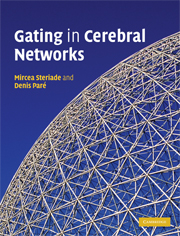In this chapter we discuss the organization, connectivity and neuronal properties of different modulatory systems located in the brainstem core, hypothalamus and basal forebrain. These systems exert widespread effects on the thalamus, neocortex, perirhinal cortices, amygdala and related subsystems. Typically, they have an activating effect on target neurons. Activation is defined as a state of readiness in cerebral networks, a state of membrane polarization which brings neurons closer to firing threshold, thus ensuring reliable synaptic transmission and quick responses (Steriade, 1991), without, however, losing sculpting inhibitory processes of short duration that are necessary during the adaptive state of waking (Jasper, 1958; Steriade, 2003c).
One of the major points in this chapter is the demonstration that none of the ascending activating systems is the awakening ‘centre’. In fact, no wake or sleep state can be said to have a centre and even few, if any, components of waking–sleep states have a centre. Functionally, a neural centre may be thought of as subserving only one function. A behavioural state centre would imply a group of neurons, homogeneous in their input–output organization and chemical code(s), and having the required pathways to control the activity of the final effectors of the events involved in that behavioural state (Steriade & McCarley, 2005). Among additional criteria, the centre, when deafferented from its major inputs, should continue to generate the state or to exhibit some of the defining electrographic signs of the state.
